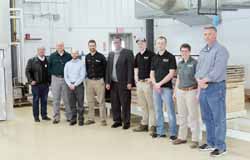
NTC Adds Vacuum Drying Kiln Here
Langlade County, already a hub of the forest products industry in the northwoods, has gained a new educational tool.
Recently local business and regional business and educational leaders gathered at Northcentral Technical College’s Wood Technology Center of Excellence in Antigo for the unveiling of a new cutting-edge kiln.

Shown standing in front of the new kiln at the Wood Technology Center are, from left, Jim Rosenberg, Wisconsin Economic Development Corporation; Scott Bowe, University of Wisconsin-Extension; Scott Lyon, Wisconsin Department of Natural Resources and Great Lakes Kiln Drying Association; Travis Allen, Northcentral Technical College; Vincent Rice, Wisconsin Economic Development Cooperation; students Dylan O’Gorman, Dakota Kakes and Jessica Becker; and Troy Brown, Kretz Lumber.
“We are excited to make this technology available to our industry partners,” Travis Allen, wood science instructor at NTC, said. “This research opportunity allows companies to assess and experience the vacuum drying technology before investing in their own unit.”
The VacuPress Technology dry kiln will be used to dry wood more quickly than a conventional drying technique.
“With limited availability of third-party research on press drying technology, we plan to provide our industry with up-to-date analysis and opportunity to compare this technology with conventional drying technique,” Allen said.
Vacuum drying uses a vacuum to create a pressure gradient between the surface and the core of the wood, while conventional drying relies on moisture gradients between the surface and core allowing water from the wetter core to move toward the dryer surface. This can be a slow process since the operator must be careful not to over dry the shell or the result will be a degrade in wood quality.
“The advantage of vacuum drying is that it allows for faster drying rates by maintaining a small differential between the shell and the core moisture contents throughout the drying period,” Allen said. “Vacuum drying is often used for high valued species or for large dimension lumber.”
NTC partnered with the Wisconsin Economic Development Corporation, the Wisconsin Department of Natural Resources and the Great Lakes Kiln Drying Association to procure the equipment through grant funds.
Source: Antigo Daily Journal
